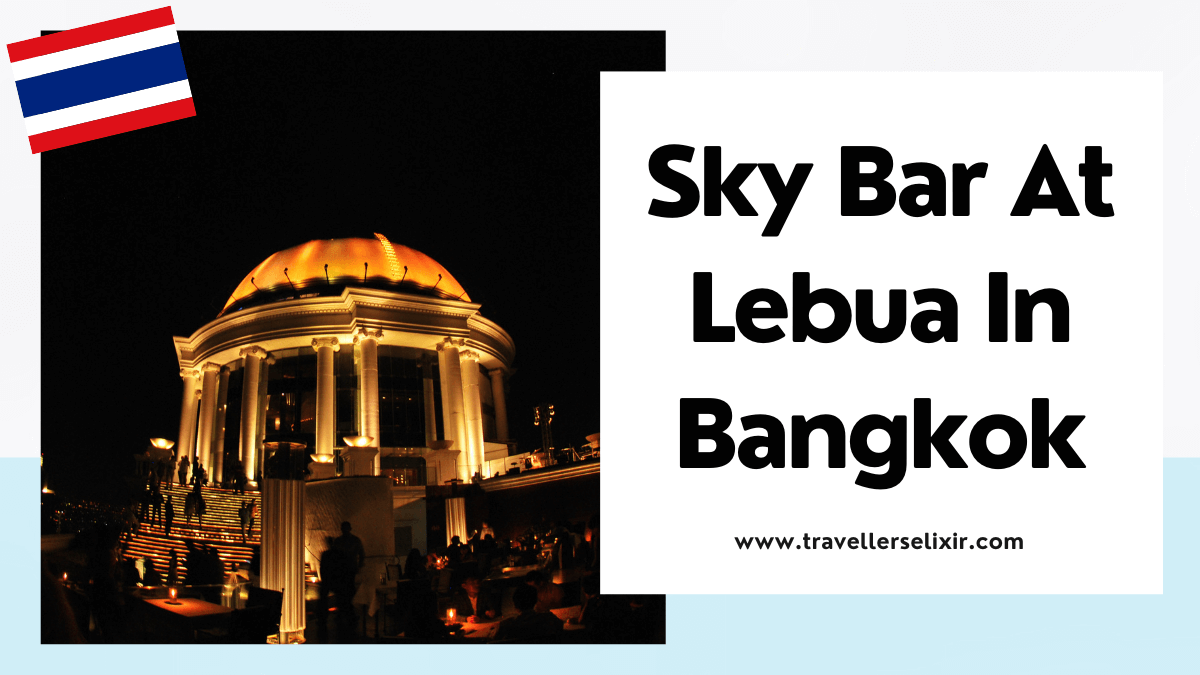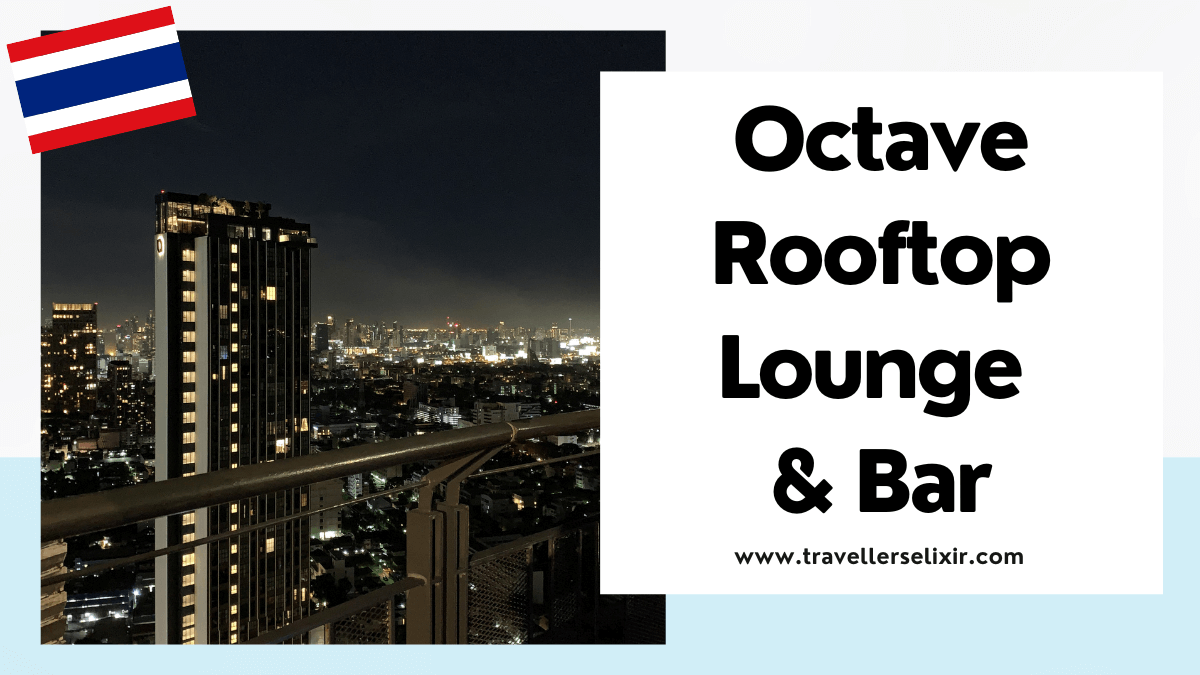Wat Arun, also known as the Temple of the Dawn, is one of Bangkok’s most recognisable sights.
This famous Buddhist temple sits along the west bank of the Chao Phraya River and can be seen from all over the city.
This guide to Wat Arun will tell you everything you need to know about visiting including the price, opening times, dress code, why you should visit and more.
What Is Wat Arun Famous For?
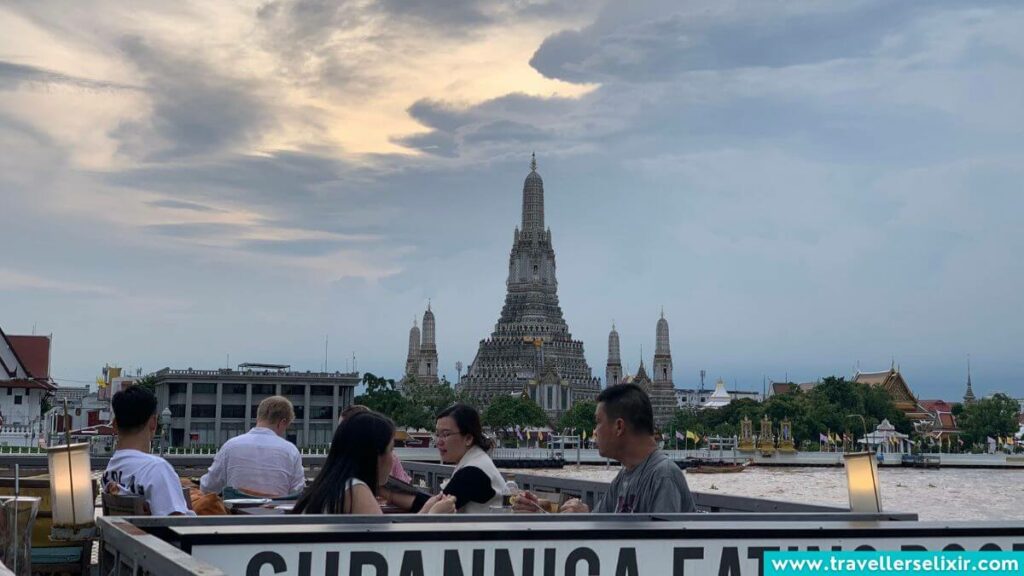
Wat Arun is mostly famous for its stunning architecture and beautiful design.
The temple is particularly famous for its central prang, which stands at 70 meters tall and is decorated with intricate colored glass and Chinese porcelain designs.
It is possible to actually climb this central spire but, be warned, it’s very steep! You will be rewarded with a great view of the river though.
The temple is named after the Hindu god Aruna, who is the god of sun. He is often depicted at the top of a rising sun.
The Wat Arun architecture is actually inspired by the Khmer-style pagodas which you’ll see in Cambodia.
Wat Arun is also known for its beautiful location on the Chao Phraya River, which offers visitors the opportunity to take a boat ride to the temple and enjoy the stunning views of the surrounding cityscape.
Wat Arun is seen as an iconic symbol of Thailand and it even features on their 10 baht coin.
That, along with its unique architecture, makes it one of Thailand’s most popular sights and it should definitely be on your list of things to do in Thailand.
What Religion Is Wat Arun Temple?
Wat Arun is a Buddhist temple.
As more than 95% of Thai people are actually Buddhist, this temple is an important place of worship for them.
It is actually considered to be one of the most important cultural and religious landmarks in the whole of Thailand.
Is Wat Arun Worth Visiting?

Yes, Wat Arun is definitely worth visiting if you’re interested in exploring Thai culture and history.
I actually lived in Bangkok for a few months so this temple became a pretty regular sight for me.
Even though I’d seen it so many times, every time I passed by I was in complete awe and couldn’t believe how beautiful it was.
This stunning architectural wonder is one of the most iconic landmarks in Bangkok so it really is a must-do activity if you’re visiting Bangkok for the first time.
It’s a great spot for taking photos (so bring along your best Thailand Instagram captions) and for enjoying panoramic views of the city.
To really make the most out of your visit, I’d recommend booking a guided tour of Wat Arun as the knowledgeable guides will tell you everything there is to know about it.
In addition to its beauty, Wat Arun has a rich history that dates back to the 17th century when it was first built making it a great place to visit if you enjoy history.
The temple was originally a palace for King Taksin and later became a sacred site for Buddhist worshippers.
As you explore the temple, you’ll have the opportunity to learn about its past and the significance of its various structures.
Overall if you have the chance to visit Bangkok, I highly recommend adding Wat Arun to your itinerary.
It’s a stunning and fascinating sight that offers a glimpse into Thai culture and history.
How Much Does It Cost To Go To Wat Arun?
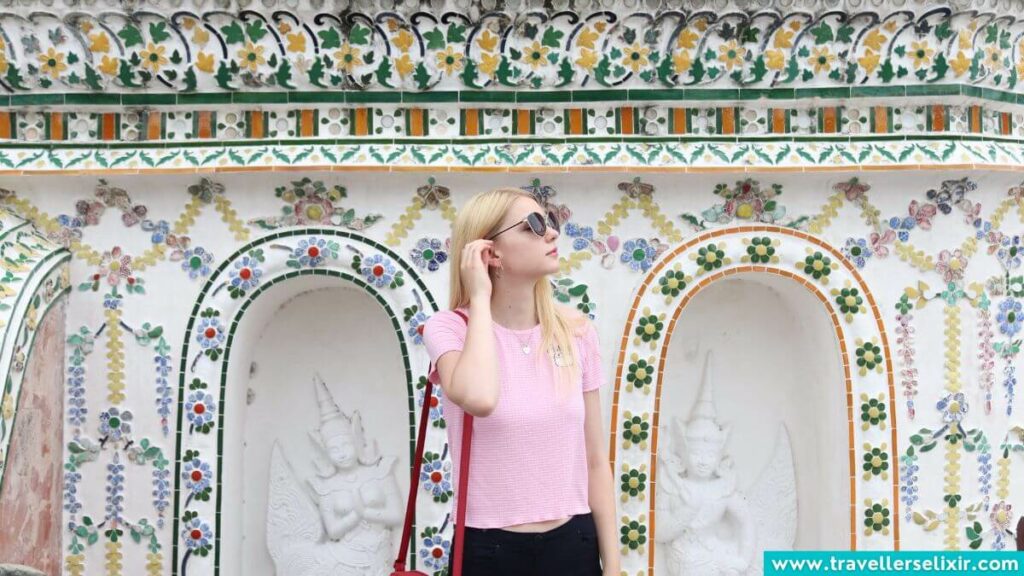
The Wat Arun ticket price is currently 100 baht which is approximately $2.90. You do also need to factor in other related costs like hiring a sarong and taking the ferry across the river.
Sarong hire at Wat Arun costs around 20 baht ($0.60) and the ferry ride across the river costs just 20 baht ($0.60).
You’ll only need to a hire a sarong if you don’t wear the right clothing (more on that later).
You should know that if you do hire a sarong at Wat Arun, they will usually also ask you to leave a 100 baht holding deposit. You’ll get the 100 baht back as long as you return the sarong.
Thai nationals can actually enter Wat Arun for free as it’s a religious site but if you’re a tourist then you’ll have to pay the 100 baht.
You can pay the Wat Arun entrance fee when you arrive or you can book a guided tour of Wat Arun online.
I’d really recommend booking a guided tour like this one if you can as you learn so much about the temple and it really makes your visit just that extra bit more special.
It’s also pretty reasonably priced so definitely won’t break the bank.
How Long Does It Take To Visit Wat Arun?
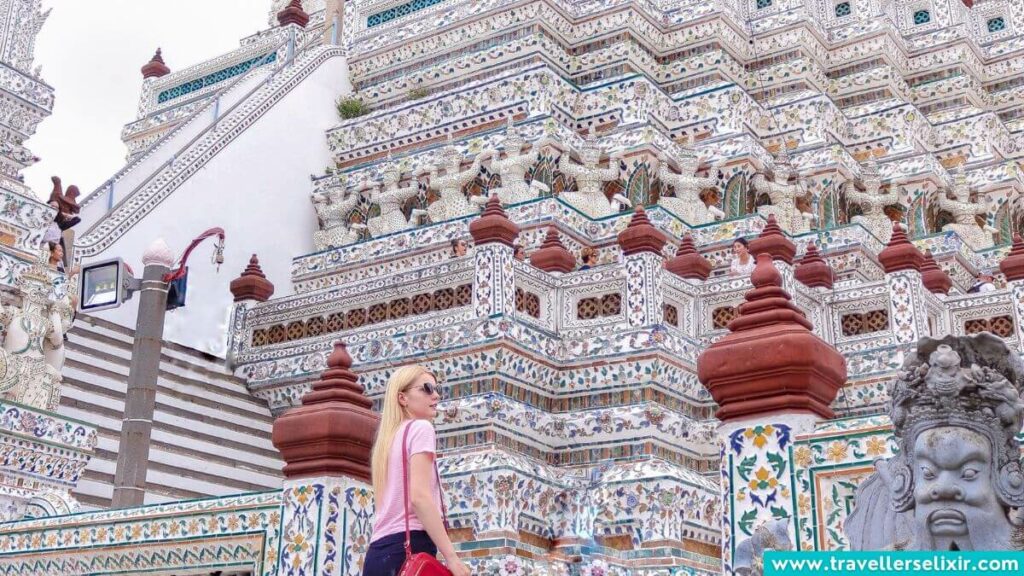
Most people spend between 1 and 2 hours exploring Wat Arun.
If you plan to take a lot of photos and explore the surrounding area then you might spend slightly longer.
Additionally, if you’re visiting during high season (December to April) then you might spend longer due to the crowds.
When I visited Wat Arun for the first time, I spent around an hour and a half wandering around.
Wat Arun itself is the main thing to see but there are a lot of other interesting buildings and features that you can see as well.
Most people spend some time climbing up the many steps of the temple, you’ll want to take this slow as it can be tiring in the heat.
Overall, I’d allow 2 hours to explore Wat Arun especially if it’s your first visit to this stunning temple.
Is There A Dress Code For Wat Arun?

The Wat Arun dress code is very strict and you will be turned away if you’re not wearing the right clothes.
Both men and women are required to cover their shoulders, knees and chest.
For men, you’ll want to wear long pants and a t-shirt that covers your shoulders.
For women, you’ll want to wear either long pants or a long skirt and a t-shirt that covers your shoulders and chest. Make sure the neck line isn’t too low.
When I visited, I found that they were very strict with both men and women here and I saw several men being turned away because they were wearing shorts.
If you’re not wearing the right clothes, don’t worry. You can rent a sarong at the entrance for 20 baht.
You do also need to leave a 100 baht holding deposit but they will give it back to you after you return the sarong.
You’ll be given a little ticket when you rent the sarong so make sure you save it to get your deposit back.
Wat Arun Opening Hours
Wat Arun is open from 8AM until 6PM every day of the week. Last tickets are usually sold around 5:30PM.
I’d recommend arriving as close to the opening time as possible but ideally before 10AM.
This is the quietest time of day so it will be easier to wander around without getting trapped amongst hoards of tourists.
Additionally, it’s really hot in Bangkok all year round so visiting in the morning is best as it’s a little bit cooler. Avoid the midday sun at all costs!
I visited the Grand Palace with my boyfriend around midday and he actually got mild sunstroke from the heat!
How To Get To Wat Arun

It’s pretty easy to get to Wat Arun from all over the city by taxi, tuk tuk or BTS.
The price and journey time will vary drastically depending on where you’re located.
Wat Arun is located close to Wat Pho and the Grand Palace so it’s a good idea to visit them all at the same time to save on transport.
The BTS will definitely be the cheapest way to get there and you’ll likely not spend more than 50 baht ($1.50).
Taxis and tuk tuks are more expensive than the BTS but they’re still pretty cheap compared to other countries and you’ll probably only spend between $3 and $5.
Wat Arun Address
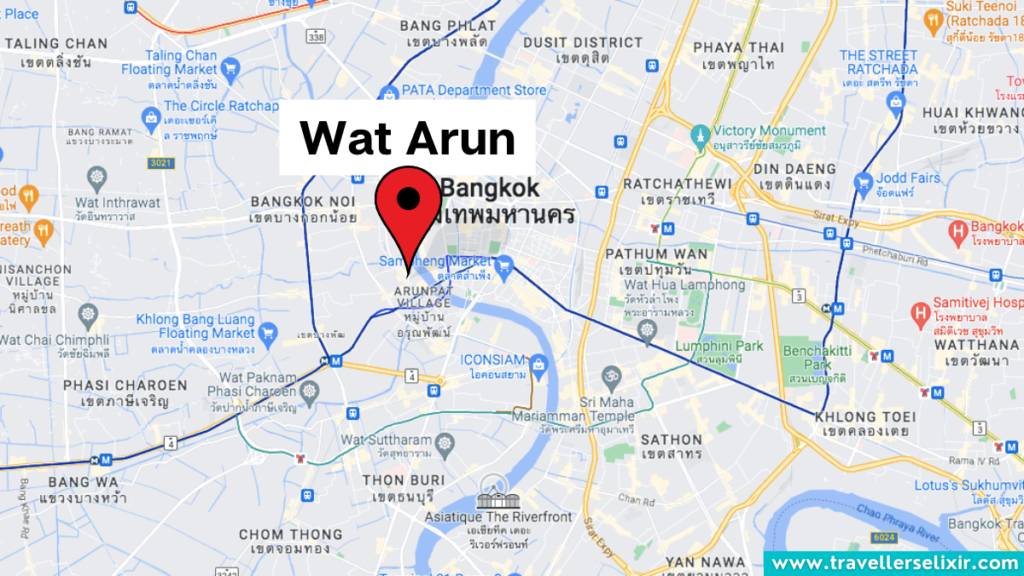
Wat Arun location: 158 Wang Doem Road, Wat Arun, Bangkok Yai, Bangkok 10600, Thailand
Wat Arun address in Thai: วัดอรุณราชวรารามราชวรมหาวิหาร (วัดแจ้ง).
This is the official address of Wat Arun in Thailand.
Getting around Bangkok can be difficult as a lot of the taxi drivers don’t speak English. If you have any trouble explaining where you want to go then show them the above address in Thai.
Also be careful that you don’t get overcharged. One thing that I found to be common in Thailand when I visited is that the taxi drivers often try to charge 3x the normal price to tourists!
That’s why I started using the Grab app instead (it’s basically Asia’s version of Uber) and it’s so much easier as you don’t have to worry about being overcharged.
What Is The Nearest BTS Station To Wat Arun?
The closest BTS station to Wat Arun is Saphan Taksin Station, however this station is still 5.6 km away.
To get to Wat Arun by BTS using public transport follow these steps:
- Take the BTS to Saphan Taksin on the Silom Line.
- When you arrive, take Exit 1 which is labeled ‘Cross-River Ferry Pier’.
- Once you get outside, walk to the Central Pier. You’ll be able to see it when you exit the station.
- When you get to the pier, follow the signs for the Chao Phraya Express Boat.
- Buy a ticket from the attendant. It should cost 20 baht ($0.60) per person.
- Board the boat and get off at Pier 8 (Ta Tian) which is located right in front of Wat Arun.
I actually did this journey recently when I visited Bangkok and it’s pretty simple.
There are so many signs everywhere helping you get around and they’re all written in English so you shouldn’t have any issues.
If you’re already at the Grand Palace or Wat Pho then you can actually take the express boat across the river for just 4 baht ($0.12)!
What Does Wat Mean In Thailand?
In Thailand, the word ‘wat’ simply means temple. Specifically, this word is used to describe a Thai Buddhist temple or monastery.
You’ll see the word ‘wat’ all over Thailand and many of Bangkok’s most famous sights include it in the name e.g. Wat Arun, Wat Pho, Wat Traimit, Wat Saket etc.
These spots are all religious temples used by the Thai people to practice their faith but due to their beauty, they’ve also become interesting tourist attractions.
So basically, if you come across anything in Thailand that is called ‘wat’, it’s a Buddhist temple.
Wat Arun History

A Buddhist temple has actually existed on the Wat Arun site since the 17th century when Thailand was part of the Ayutthaya Kingdom.
Following the fall of this kingdom, King Taksin restored the temple and renamed it Wat Chaeng (the locals still call it this).
When he first arrived at the temple, it is said that dawn was breaking and so Wat Chaeng actually means ‘temple of the dawn’ which is where Wat Arun’s famous nickname comes from.
King Taksin decided to create a new capital here called Bangkok. Previously the capital was in Ayutthaya.
For some time after this, Wat Arun was located within the grounds of the royal palace where it served as the royal chapel.
It also housed the famous Emerald Buddha which today you’ll find in nearby Wat Phra Kaew.
In 1785, King Rama I moved the royal palace to the other side of the river to what is today the Grand Palace.
Following this move, Wat Arun was left abandoned until the reign of Rama II.
Rama II began restorations of the temple but these weren’t completed until the reign of Rama III.
During this time, the spires of the temple were raised, and Rama III added the porcelain decorations which are now one of the temple’s most defining features.
And that’s it!
Thanks for reading this post all about the Wat Arun temple in Bangkok, Thailand.
I highly recommend visiting Wat Arun if it’s your first time visiting Thailand as this sight really does need to be seen to be believed.
One funny thing that I noticed at a lot of the temples in Thailand is that a lot of the locals leave red fanta bottles at the shrines!
It sounds a bit odd but it does have a very important meaning so keep an eye out for it when you visit.
Related Posts:



